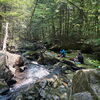Processing Your Payment
Please do not leave this page until complete. This can take a few moments.
- News
-
Editions
View Digital Editions
Biweekly Issues
- December 1, 2025
- Nov. 17, 2025
- November 03, 2025
- October 20, 2025
- October 6, 2025
- September 22, 2025
- + More
Special Editions
- Lists
- Viewpoints
-
Our Events
Event Info
Award Honorees
- Calendar
- Biz Marketplace
Irving’s plan for Aroostook lakes region includes commercial, residential development
J.D. Irving’s proposed concept plan for 51,000 acres in Aroostook County asks the Maine Land Use Planning Commission to allow new commercial and residential development around the Fish River Lakes chain, in addition to conservation plans and continued logging operations.
The Bangor Daily News reported the plan for Irving’s acreage will go to public hearings later this month. Anthony Hourihan, Irving’s director of land development, told the BDN that there already are 400-plus existing camp lot leases at the lakes, adding “if we are going to allow future development it makes sense to do it where there is already that development.”
According to the Maine Department of Agriculture, Conservation and Forestry, Irving’s proposal involves rezoning a portion of its land in the Fish River Lakes region in Aroostook County to a "resource plan protection subdistrict" in order to implement the concept plan. The plan and related documents can be found on Department of Agriculture, Conservation and Forestry’s website.
Concept plans are landowner-created, long-range plans for the development and conservation of a large area. These plans are a clarification of long-term landowner intent that indicate, in a general way, the areas where development is to be focused, the relative density of proposed development, and the means by which significant natural and recreational resources are to be protected.
Pro and con on Irving’s plan
According to pre-filed testimony by Noel A. Musson, a professional planner and principal of The Musson Group in Southwest Harbor, who has been involved with developing the Fish River Chain of Lakes Concept Plan since 2012, the plan encompasses approximately 51,000 acres in northern Aroostook County. It includes land within six unorganized townships and substantial frontage on Long Lake, Mud Lake, Cross Lake and Square Lake, as well as frontage along the thoroughfares that connect these lakes. The area also encompasses three smaller bodies of water: Carry Pond, Dickey Pond and Little California Pond, as well as several named and unnamed streams. The area is traversed by Route 161 and Route 162 and a network of forest management roads.
Considerations in developing the concept plan included:
- Where is the existing development already?
- What are Irving’s needs in terms of unfragmented forest blocks?
- What are the existing natural and recreational resources and how can impacts be minimized?
- Site-specific considerations like topography and soils.
Another element of the concept plan was to provide the regulatory framework for allowing opportunities for a diverse range of uses — including seasonal and year-round homes, recreational lodging, remote campsites and small businesses.
According to Musson, the plan identifies 15 areas that could support some level of development, while also avoiding resources and minimizing fragmentation of the surrounding working forest.
In its pre-filed testimony, the Natural Resources Council of Maine said it could not support the application as proposed. Specific objections include:
- Irving’s proposed development on Square Lake and “Cross Lake E” would cause permanent harm to the character and natural resources of the region.
- The proposed amount and location of permanent conservation is insufficient to achieve a publicly beneficial balance with the development proposed, to provide comparable conservation, and to avoid or mitigate adverse impacts to natural, scenic and recreational resources.
- The conservation easement lacks clear enforceable provisions, and other provisions and vague concept plan commitments do not ensure that the conservation objectives of the easement or of the plan as a whole will be achieved.
Mainebiz web partners

The Giving Guide
The Giving Guide helps nonprofits have the opportunity to showcase and differentiate their organizations so that businesses better understand how they can contribute to a nonprofit’s mission and work.
Learn More
Work for ME
Work for ME is a workforce development tool to help Maine’s employers target Maine’s emerging workforce. Work for ME highlights each industry, its impact on Maine’s economy, the jobs available to entry-level workers, the training and education needed to get a career started.
Learn More
Groundbreaking Maine
Whether you’re a developer, financer, architect, or industry enthusiast, Groundbreaking Maine is crafted to be your go-to source for valuable insights in Maine’s real estate and construction community.
Learn more-
The Giving Guide
The Giving Guide helps nonprofits have the opportunity to showcase and differentiate their organizations so that businesses better understand how they can contribute to a nonprofit’s mission and work.
-
Work for ME
Work for ME is a workforce development tool to help Maine’s employers target Maine’s emerging workforce. Work for ME highlights each industry, its impact on Maine’s economy, the jobs available to entry-level workers, the training and education needed to get a career started.
-
Groundbreaking Maine
Whether you’re a developer, financer, architect, or industry enthusiast, Groundbreaking Maine is crafted to be your go-to source for valuable insights in Maine’s real estate and construction community.
ABOUT
NEW ENGLAND BUSINESS MEDIA SITES
No articles left
Get access now
In order to use this feature, we need some information from you. You can also login or register for a free account.
By clicking submit you are agreeing to our cookie usage and Privacy Policy
Already have an account? Login
Already have an account? Login
Want to create an account? Register
Get access now
In order to use this feature, we need some information from you. You can also login or register for a free account.
By clicking submit you are agreeing to our cookie usage and Privacy Policy
Already have an account? Login
Already have an account? Login
Want to create an account? Register







Comments